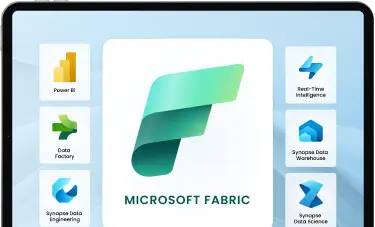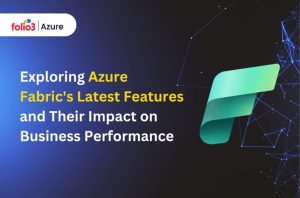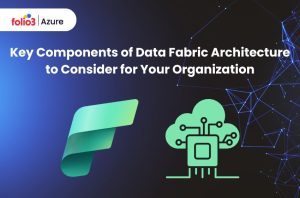Table of Contents
ToggleThe universe of data is expanding exponentially, and the world that we live in today is exploding with data, with the world becoming short of it. According to the latest estimates given by Explodingtopics, an enormous 402.74 million terabytes of data are created daily.
Thus, it mandates businesses to move from on-premise to cloud solutions.
Amazon Web Services (AWS) is the world’s most adopted cloud, whereas Microsoft Fabric is a cloud-based SaaS solution for data and analytics that combines various Microsoft tools to streamline all data and analytics workflows. Connecting to AWS data sources with Fabric provides an easy and efficient way to manage your hybrid cloud infrastructure.
As businesses rely heavily on data-driven decisions, integrating Microsoft Fabric with AWS data sources gives them flexibility, scalability, and cost-efficiency. By combining AWS with Microsoft’s Fabric, you can create a powerful duo and a hybrid cloud solution that lets you manage your resources on both platforms.
But how do you integrate AWS data services with Microsoft Fabric for effective hybrid cloud integration? This article will guide you through every step to achieve a successful integration.
Accelerate smart decisions with Microsoft Fabric's unified data and AI analytics.

Steps to Integrate Microsoft Fabric with AWS Data Sources
Here are the steps to integrate Microsoft Fabric with AWS Data Sources.
Step 1: Setting Up Data Pipelines
To start the process, connect to AWS data sources with Fabric and configure data pipelines. Microsoft Fabric provides multiple ways to ingest data from AWS. You can start by configuring Microsoft’s OneLake or setting up connectors for services like Amazon S3. A secure data flow from AWS into Fabric must be established for your insights to be accurate.
To set up data pipelines, you must authenticate your AWS account within Microsoft Fabric using Fabric’s built-in connectors. These connectors provide access to AWS data services, making your integration easy.
Azure Synapse integration with AWS is another strategy you can consider adopting, especially if you’re already using Synapse for analytics and want to enhance hybrid cloud integration.
Step 2: Ensuring Data Security and Compliance
Security against threats and data breaches is a prime concern when handling data in cloud environments. Hybrid cloud integration has unique challenges, especially when sensitive data is transferred between AWS and Microsoft Fabric.
To protect data, you must use encryption while it is being transferred and stored. Utilize AWS’s IAM roles and Microsoft’s identity management for secure user access, letting only authorized personnel manage and transfer data.
Moreover, compliance with security regulations must be a top priority in your AWS data services integration process. By using private endpoints and VPNs, you must warrant that your setup complies with GDPR, HIPAA, or other industry standards.
Strict compliance guarantees that your hybrid cloud integration remains secure and conforms with the law, protecting your business from legal risks.
Step 3: Orchestrating Data Flows
After you have connected your AWS data sources with Microsoft Fabric, the next step is orchestrating data flows between the two environments. Azure Data Factory lets you set up automated workflows to connect AWS data sources with Fabric and schedule data movement between AWS and Microsoft Fabric in real-time.
Orchestration tools like Azure Data Factory let you devise complex workflows without writing complex code. This orchestration enables you to achieve smooth hybrid cloud integration by managing dependencies and workflows in AWS and Microsoft environments.
A successful data flow management system can avoid delays and data bottlenecks, regardless of whether you’re moving processed or raw data.
Step 4: Analyzing and Visualizing Data
After ingesting data into Microsoft Fabric from AWS, it’s time to analyze and visualize it. Power BI, a tool that integrates easily with Microsoft Fabric, lets you create interactive dashboards and reports based on your moved data.
With AWS data services integration, you can execute complex queries and analysis on your AWS-hosted data directly within Microsoft Fabric, maximizing the power of Synapse Analytics.
Azure Synapse integration with AWS boosts your ability to process enormous datasets. This powerful combination makes your hybrid cloud integration a powerful analytics tool. Whether real-time data insights or predictive analytics, Power BI and Synapse Analytics let you benefit from the maximum potential of your hybrid cloud data.
Benefits of a Hybrid Cloud Approach
The Hybrid Cloud approach comes with a myriad of benefits, let’s discuss some of them:
1. Flexibility and Scalability
One of the core benefits of a hybrid cloud solution is the flexibility it offers. With AWS data services integration and connecting to AWS data sources with Fabric, you can have the best of both worlds.
AWS offers massive scalability and advanced data management tools, while Microsoft Fabric provides powerful analytics and data orchestration capabilities. This flexibility allows you to scale up or down based on your business needs without being locked into a single cloud provider.
With hybrid cloud integration, you can distribute workloads across AWS and Microsoft Azure, ensuring you never run out of resources. The combination of these platforms provides the ultimate scalability and adaptability for growing businesses.
2. Cost Efficiency
Another notable benefit of hybrid cloud integration is cost savings. By using both AWS and Microsoft Fabric, you can maximize resource usage and cut down expenses. For example, you can store less frequently accessed data on AWS’s cost-effective storage solutions while using Microsoft Fabric for real-time data analytics and decision-making.
Hybrid cloud solutions also help you avoid over-provisioning of resources. You can use Azure Synapse integration with AWS to offload high-computation tasks to the most cost-effective platform, warranting that your hybrid cloud environment is always cost-efficient and efficient.
3. Improved Data Availability and Redundancy
You have enhanced data availability and redundancy by embracing a hybrid cloud solution. Your data is not limited to a single cloud environment, minimizing the risk of downtime or data loss.
By connecting to AWS data sources with Fabric, you can store backups in multiple locations across AWS and Microsoft Azure, guaranteeing that your essential business data is always available.
AWS data services integration with Microsoft Fabric also helps you set up disaster recovery plans. Thus, even if one cloud provider experiences an outage, your data and applications can continue running without disruption. This redundancy provides peace of mind, knowing that your hybrid cloud integration is built for resilience.
Conclusion
Integrating Microsoft Fabric with AWS data sources provides businesses with high flexibility, solid security, and massive cost savings that a hybrid cloud solution provides. You can create a solid hybrid cloud environment by carefully following the steps mentioned above, setting up data pipelines, warranting data security, orchestrating flows, and analyzing data. This integration lets you gain the benefits of both Microsoft and AWS, giving you an edge in managing your data resources.
So, are you ready to take the next step? Then, exploring connecting to AWS data sources with Fabric can enrich your hybrid cloud strategy. Whether you are scaling up your operations, improving data redundancy, or managing costs, a well-designed hybrid cloud solution can meet your business needs.
Start by contacting our experts for guidance on reaping the benefits of Microsoft Fabric and AWS integration. Visit us at Folio3 Microsoft Fabric to learn more about how we can assist you in making this transition.


